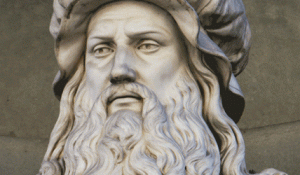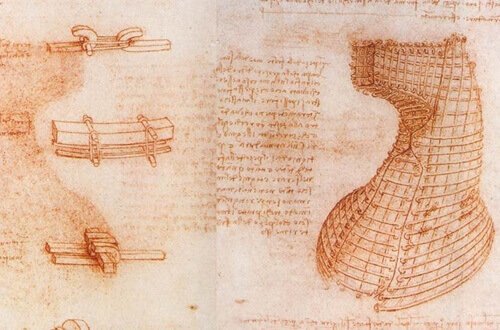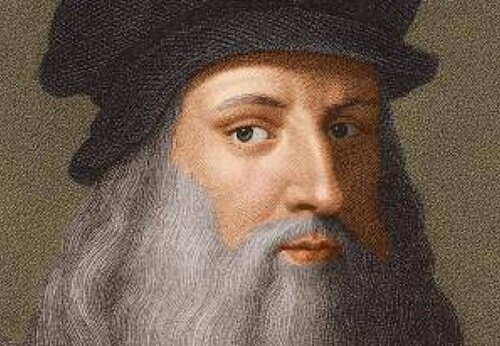Leonardo da Vinci: A Renaissance Visionary


Written and verified by the psychologist Valeria Sabater
Leonardo da Vinci was a painter, inventor, scientist, architect, musician, and writer. He was well-versed in many disciplines that he commanded with his visionary character. Due to this, he became a Renaissance man.
It’s common to experience a mixture of curiosity and admiration when we hear his name. Moreover, pieces such as The Last Supper, Lady with an Ermine, and The Vitruvian Man immediately pop into our minds. However, most people tend to neglect his innumerable contributions to the field of engineering.
His flying machine and sketches of parachutes and diving equipment were some of his other contributions. Leonardo da Vinci was, above all, a pioneer in the experimental method. He managed to get ahead without even knowing it.
Leonardo had endless curiosity, which made him a passionate student of nature, science, and research. He filled his notebooks with ideas, projects, sketches, and hypotheses that, to this day, are difficult to interpret.
Leonardo da Vinci even encrypted his ideas and thoughts through mirror writing to make it difficult for people to read his words.
“There are three classes of people: those who see, those who see when they are shown, those who do not see.”
-Leonardo da Vinci-
The formation of a young Florentine
Leonardo da Vinci was born in Anchiano, Tuscany, in 1452. He was the product of a sexual relationship between Caterina di Meo Lippi, a young peasant, and Piero da Vinci, a Florentine notary.
Da Vinci’s parents never married. However, Leonardo spent his early years in his father’s house, where he interacted with the rest of his paternal family. He grew up as the legitimate son of Antonio da Vinci. The education he received wasn’t prominent. He learned to read and write and excelled in math. However, according to historians, he didn’t master Latin.
He showed great artistic talent at the age of 15. His father, who appreciated this talent, sent him to be the apprentice of famous sculptor and painter, Andrea del Verrocchio. He spent about ten years there, where he excelled in painting and sculpting, as well as in the mechanical arts.

Moreover, many historians believe that Leonardo left Florence to try to outshine his former teacher, Andrea del Verrocchio.
Leonardo’s Horse
Da Vinci’s commission was to build a rampant bronze horse: a 22-feet-high sculpture. This was quite challenging for the time.
The sculpture was first modeled with clay. It was such a large sculpture that it left everyone who came to Milan breathless. However, due to the Italian wars, it was never completed in bronze. This metal was destined to the fabrication of artillery guns instead.
The Last Supper
During his stay in Milan, between 1495 and 1498, Leonardo da Vinci created one of his most famous works: The Last Supper. It was a mural painting created for the refectory of the Convent of Santa Maria delle Grazie in Milan, Italy.
It symbolizes the Passover Seder dinner and the moment when Jesus reveals to his apostles that one of them will betray him. This painting is quite striking due to its dimensions, 350 inches wide by 180 inches high. It was an artistic accomplishment that, for many, borders on perfection. It’s an exquisite dynamic composition, full of symbolism and meaning.
The Last Supper is the type of painting that we can understand better if we divide it and observe the figures in groups of three. When we do that, we discover how an apparently static painting is actually dynamic. We also discover that it’s filled with symbolism, secrets, and fascinating nuances.
Leonardo da Vinci: A man enlightened before its time
Sigmund Freud said that Leonardo da Vinci was a man who woke up too early from the darkness of his time. His prodigious and visionary mind was quite advanced for his time.
He was fascinated by the human body. The man didn’t hesitate to acquire corpses he could dissect in order to better understand anatomy.
In addition, his eclectic knowledge and passion for investigating more and more about nearly every subject was also a significant problem for him.
To this day, we have multiple sketches that never made it to a canvas. From 1490 on, da Vinci spent more time observing, testing hypotheses, and designing in his notebooks than actually finishing a lot of the work he started.

Leonardo da Vinci died in 1519 when he was 67 years old. However, his legacy, his talent, and the mysteries in his work and notebooks still live on and inspire dozens of books every year.
Leonardo da Vinci was a painter, inventor, scientist, architect, musician, and writer. He was well-versed in many disciplines that he commanded with his visionary character. Due to this, he became a Renaissance man.
It’s common to experience a mixture of curiosity and admiration when we hear his name. Moreover, pieces such as The Last Supper, Lady with an Ermine, and The Vitruvian Man immediately pop into our minds. However, most people tend to neglect his innumerable contributions to the field of engineering.
His flying machine and sketches of parachutes and diving equipment were some of his other contributions. Leonardo da Vinci was, above all, a pioneer in the experimental method. He managed to get ahead without even knowing it.
Leonardo had endless curiosity, which made him a passionate student of nature, science, and research. He filled his notebooks with ideas, projects, sketches, and hypotheses that, to this day, are difficult to interpret.
Leonardo da Vinci even encrypted his ideas and thoughts through mirror writing to make it difficult for people to read his words.
“There are three classes of people: those who see, those who see when they are shown, those who do not see.”
-Leonardo da Vinci-
The formation of a young Florentine
Leonardo da Vinci was born in Anchiano, Tuscany, in 1452. He was the product of a sexual relationship between Caterina di Meo Lippi, a young peasant, and Piero da Vinci, a Florentine notary.
Da Vinci’s parents never married. However, Leonardo spent his early years in his father’s house, where he interacted with the rest of his paternal family. He grew up as the legitimate son of Antonio da Vinci. The education he received wasn’t prominent. He learned to read and write and excelled in math. However, according to historians, he didn’t master Latin.
He showed great artistic talent at the age of 15. His father, who appreciated this talent, sent him to be the apprentice of famous sculptor and painter, Andrea del Verrocchio. He spent about ten years there, where he excelled in painting and sculpting, as well as in the mechanical arts.

Moreover, many historians believe that Leonardo left Florence to try to outshine his former teacher, Andrea del Verrocchio.
Leonardo’s Horse
Da Vinci’s commission was to build a rampant bronze horse: a 22-feet-high sculpture. This was quite challenging for the time.
The sculpture was first modeled with clay. It was such a large sculpture that it left everyone who came to Milan breathless. However, due to the Italian wars, it was never completed in bronze. This metal was destined to the fabrication of artillery guns instead.
The Last Supper
During his stay in Milan, between 1495 and 1498, Leonardo da Vinci created one of his most famous works: The Last Supper. It was a mural painting created for the refectory of the Convent of Santa Maria delle Grazie in Milan, Italy.
It symbolizes the Passover Seder dinner and the moment when Jesus reveals to his apostles that one of them will betray him. This painting is quite striking due to its dimensions, 350 inches wide by 180 inches high. It was an artistic accomplishment that, for many, borders on perfection. It’s an exquisite dynamic composition, full of symbolism and meaning.
The Last Supper is the type of painting that we can understand better if we divide it and observe the figures in groups of three. When we do that, we discover how an apparently static painting is actually dynamic. We also discover that it’s filled with symbolism, secrets, and fascinating nuances.
Leonardo da Vinci: A man enlightened before its time
Sigmund Freud said that Leonardo da Vinci was a man who woke up too early from the darkness of his time. His prodigious and visionary mind was quite advanced for his time.
He was fascinated by the human body. The man didn’t hesitate to acquire corpses he could dissect in order to better understand anatomy.
In addition, his eclectic knowledge and passion for investigating more and more about nearly every subject was also a significant problem for him.
To this day, we have multiple sketches that never made it to a canvas. From 1490 on, da Vinci spent more time observing, testing hypotheses, and designing in his notebooks than actually finishing a lot of the work he started.

Leonardo da Vinci died in 1519 when he was 67 years old. However, his legacy, his talent, and the mysteries in his work and notebooks still live on and inspire dozens of books every year.
All cited sources were thoroughly reviewed by our team to ensure their quality, reliability, currency, and validity. The bibliography of this article was considered reliable and of academic or scientific accuracy.
- Fritjof, Capra (2008) La Ciencia de Leonardo. Anagrama
- Isaacson, Walter (2018) Leonardo da Vinci: La biografía. Debate
This text is provided for informational purposes only and does not replace consultation with a professional. If in doubt, consult your specialist.







